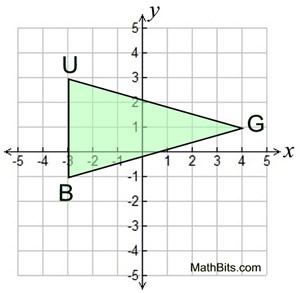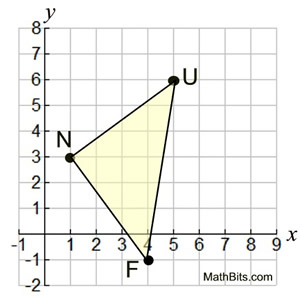|
Directions: Grab a paper and pencil to make your computations.
1. |
Given ΔBUG as shown with
B(-3,-1), U(-3,3) and G(4,1).
Find the area of triangle BUG.
Choose:
|
 |
|
2. |
Given parallelogram PQRS with
P(-4,-2), Q(-2,3), R(4,3) and
S(2,-2).
a) Find the perimeter of PQRS.
Choose:
b) Find the area of PQRS in sq. units.
Choose:
|
|
|
3. |
Given ΔNUF as shown with N(1,3),
U(5,6), and F(4,-1).
Find the area of
ΔNUF.
Choose:
|
 |
|
4. |
Given pentagon ABCDE with
A(1,5), B(4.5,8), C(8,5),
D(6.5,0)
and E(2.5,0).
Find the area of ABCDE.
Choose:
|
|
|
5. |
Given quadrilateral ABCD with
A(-4,-2), B(-3,2), C(2,4) and
D(4,-3).
a) Find the area in square units.
Choose:
b) Find the perimeter to the nearest unit.
Choose:
|
|
|
6. |
Triangle SAM has coordinates
as shown. Find the perimeter of the triangle. Express answer in simplest radical form.
Choose:
|
|
|
7. |
Given polygon ABCDEF as shown at the right. Assume coordinates are integer values. Find the area of polygon ABCDEF.
Choose:
|
|
|
8. |
A grid overlay is placed over a kite,
as shown at the right.
a) Based upon the grid, find the area of the kite.
Choose:
b) Based upon the grid, find the perimeter of the kite to the nearest tenth of a unit.
Choose:
|
|
|

NOTE: The re-posting of materials (in part or whole) from this site to the Internet
is copyright violation
and is not considered "fair use" for educators. Please read the "Terms of Use". |
|